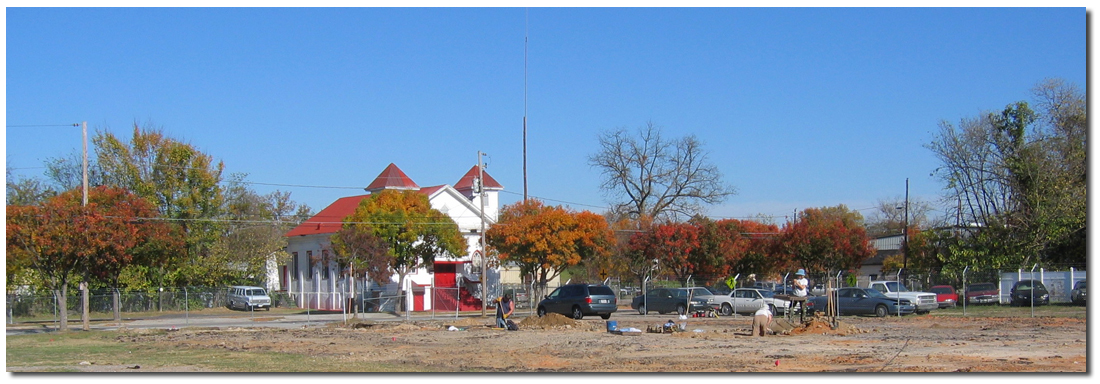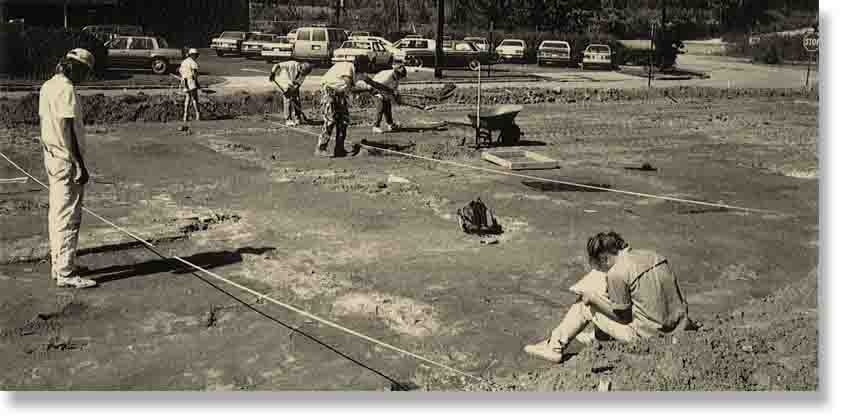 |
|||||
 |
|||||
ARCHAEOLOGY OF SPRINGFIELD
INTRODUCTION TO SPRINGFIELD ARCHAEOLOGY
SPRINGFIELDS’S HISTORIC LANDSCAPE
SPRINGFIELD HOUSE FROM THE RIVERFRONT AUGUSTA ARCHAEOLOGY STUDY
LIFE IN ANTEBELLUM SPRINGFIELD
CHANGE AND DIVERSITY IN POST-WAR SPRINGFIELD
THE NINIVIEN PIPE: A SYMBOL OF HOPE AND FREEDOM
AFRICAN AMERICAN ARCHAEOLOGY IN GEORGIA
|
(Above) Archaeologists Working at the Riverfront Augusta Site During the Early 1990s. (Photo: New South Associates, Inc.).
Brick Pier from a Nineteenth-Century House on Jones Street, Augusta. Archaeological excavations at the St. Sebastian Way project indicated that at least some houses in the predominantly African American Jones Street area were built in an informal way, with mismatched footings instead of well-made, full foundations. (Photo: Brad Botwick, New South Associates, Inc.).
|
INTRODUCTION TO SPRINGFIELD ARCHAEOLOGY Archaeological investigations in Augusta have provided important information about the Springfield community. The first archaeological study of the community was completed in preparation for building the Augusta Riverfront Convention Center, while later studies have provided additional information. Through the archaeological work, we have learned about how the Springfield neighborhood looked, what kinds of houses people lived in, and other aspects of diet and lifestyle. Archaeologists working in cities must remove pavement and sidewalks and other modern construction to get at the ground and see what artifacts are buried under the surface. Archaeologists make careful notes and records of their excavations because once a site has been dug, it has also been destroyed. For the Riverfront Augusta site, the archaeologists used heavy machinery to strip the upper dirt away, and then mapped what they saw underneath. Things that they found, mapped, and excavated included brick foundation walls, brick wells, brick and wooden privies, stains in the ground where pits had been dug, and stains in the dirt where wooden posts had rotted away. All of these archaeological evidences of human activity on the landscape are called features. After fieldwork on a site is done, the artifacts are washed and analyzed and a report is prepared. The artifacts then go to a museum or university for storage. The archaeologists learn about a site not only from the artifacts they find, but also from where the artifacts were, and their associations with the locations of the features on the site. For an archaeologist, an artifact is important because of its context (where and when did it come from and who used it) and what that artifact can tell about the past.
|
|
|
 Archaeological Excavation Taking Place at the St. Sebastian Way Project in Augusta, Georgia in 2006, with the Jerusalem Missionary Baptist Church in the Background. This study provided information about the historic landscapes and housing conditions associated with Springfield during the nineteenth and early twentieth centuries. (Photo: Brad Botwick, New South Associates, Inc.).
Archaeological Excavation Taking Place at the St. Sebastian Way Project in Augusta, Georgia in 2006, with the Jerusalem Missionary Baptist Church in the Background. This study provided information about the historic landscapes and housing conditions associated with Springfield during the nineteenth and early twentieth centuries. (Photo: Brad Botwick, New South Associates, Inc.).

